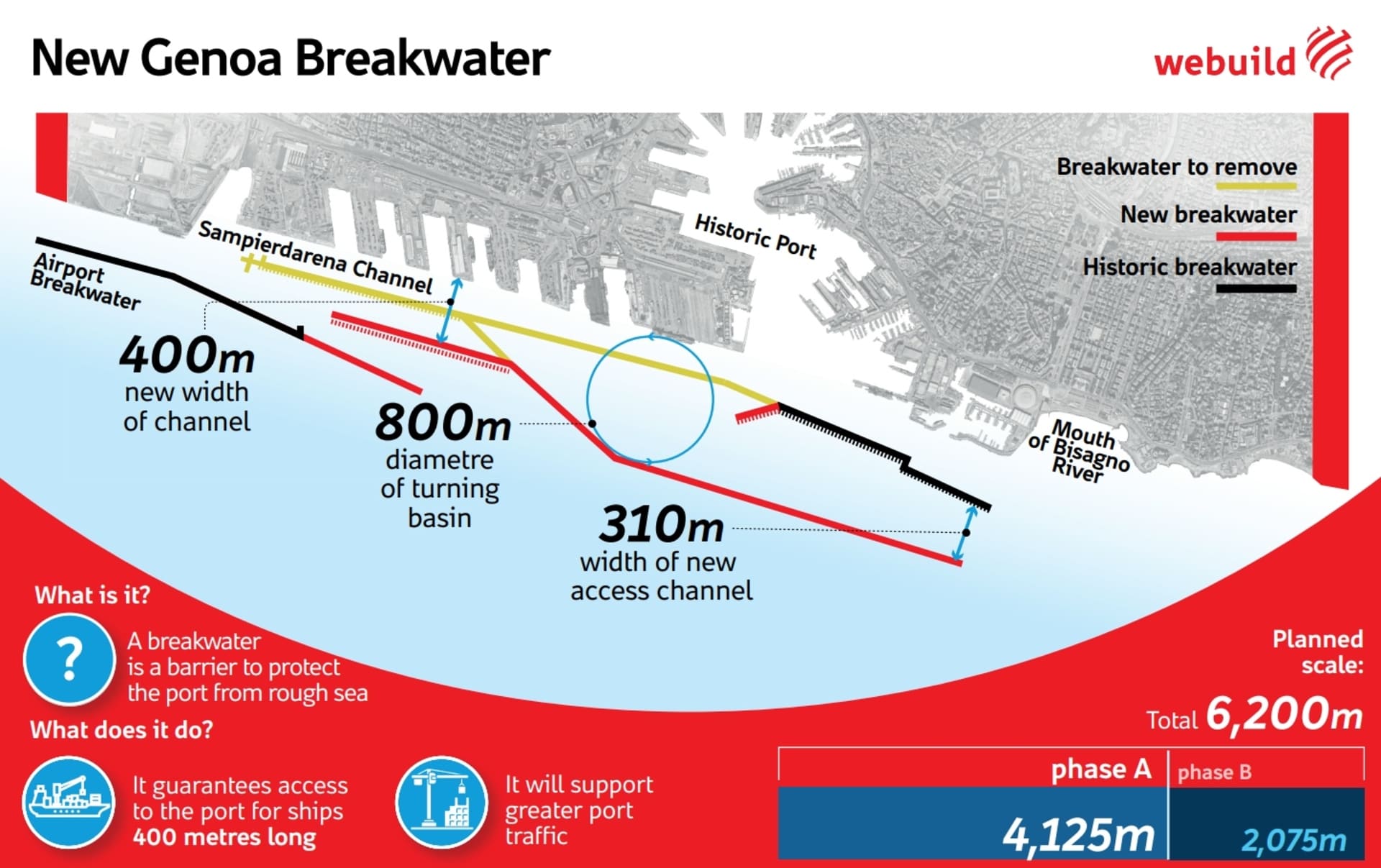In the middle of the sea, 310 meters further out than the existing pier, Genoa salutes its new breakwater pier. It’s a uniquely complex project, one of the most important works in the history of Italian harbor development, and most of all an infrastructure that will change Liguria’s capital putting it back on the map, as it was when Genoa was a leading Mediterranean seafaring power.
Work on the new breakwater pier will begin on May 4 with a celebration in the sea in front of the harbor. With this new pier Genoa will be able to welcome the largest container ships, those measuring 400 meters, which today dominate global seafaring trade with their cost effectiveness and lower air pollution.
The realization of the project, assigned in December 2022 to the Consortium “Per Genova Breakwater,” headed by the Webuild group, is shooting for the medium term: in 2026 the first phase will be completed. While in 2030 the pier will be finished, with all the Sampierdarena terminals operational. That is when the city will be able to finally become once again a strategic mercantile hub, not just for Europe but for the entire world.
The cornerstone of a project that is unique in the world
May 4 is the date chosen for the laying of the project’s “cornerstone,” the first concrete pour in open sea that will signal the construction start of the new breakwater pier. The project entails a pier raised 310 meters beyond the existing one, 6,200 meters long, resting on the sea floor at depths of up to 50 meters, one of the deepest in the world and the largest in Europe. It’s a complex and highly innovative work, and will require about a thousand people to build it from now until 2030. The first phase of the work, which will end in 2026, includes the construction of the base, at a depth of 50 meters, using 7 million tons of rocks, on top of which will be positioned concrete elements composed of some 100 cellular concrete caissons. Each caisson will be 33 meters high, as much as a ten story building, 35 meters wide and 67 meters long. These numbers confirm the grandiosity of this construction, which will conclude the first phase in 2026, and then terminate the last phase by 2030.
Genoa’s breakwater pier: an innovative project for a sustainable public work
It is possible to build a dam while respecting the most stringent sustainability criteria. That was the goal of the designers who worked on the feasibility studies of the project, which was conceived not just to enlarge the harbor but also to protect the basins and the port structures from climate change. Overall, the construction of the infrastructure is based on the concept of reusing old materials, especially the almost complete recycling of the old pier, which will be demolished and its materials employed again, thus minimizing significantly the environmental impact of the construction phase, reducing transport operations and fuel consumption. The cellular caissons that will be laid at the bottom of the sea, will be built in the nearby Voltri harbor, made waterproof with a special concrete mix, and filled with inert recycled materials, like those stemming from the demolition of the old pier.
The pier that will give Genoa a new look
Genoa’s harbor is a strategic infrastructure for the country. Currently its piers handle 66 million tons of goods a year, covering a third of Italy’s container traffic.
According to Ports of Genoa, the harbor authority that manages the port, without the new breakwater, container traffic would decline by 6.8% a year, reaching a 50% reduction in tonnage by 2030. On the contrary, the new pier will allow the city to conquer market share year after year, coming to manager by 2030 5 and 6 million TEUs In addition, Ports of Genoa estimates that the new pier will generate an economic benefit of 4.2 billion euros in terms of higher income from container traffic, rights and harbor fees.
Genoa has a favorable geographical location compared to Rotterdam, Europe’s leading cargo port, when it comes to trade with the great ports of South East Asia. The Italian harbor is in fact 1,000 miles closer to Singapore, Shanghai, Cina and Yokohama, Japan. That is a characteristic that confirms how Genoa may well become in the next few years a strategic hub for world trade, counting also on the transport infrastructures that from the San Giorgio bridge to the high speed rail link Terzo Valico dei Giovi-Nodo di Genova connect and will connect the city to the rest of Europe.


